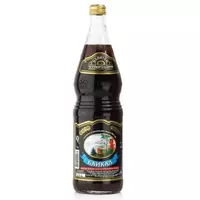Drink baikal

In absolutely any modern grocery store, shelves are replete with carbonated waters and juices, but it is unfortunately quite difficult to find the once unusually popular drink Baikal. True, not so long ago he reappeared on domestic shelves, causing nostalgia about the past 70s.
Interestingly, the roots of the creation of the Baikal drink go back to 1767 - that's when Joseph Priestley first successfully dissolved carbon dioxide in water. Developing his experiments, a few years later he built a saturator, which was a special apparatus for saturating water with carbon dioxide bubbles. So the first soda appeared.
The birth of lemonade marked the beginning of the 19th century - this was due to the development of a special technological process for the isolation of citric acid from the citrus of the same name. At the same time, the further development of this industry led to the production of carbonated waters based on extracts and roots of different plants.
Not left behind the whole world and the USSR - in 1973, specialists from the Research Institute of Brewing Non-Alcoholic and Wine Industry created a drink made from licorice root, St. John's wort and eleuterococcus, which received the proud name "Baikal. " In a fairly short period of time, this brand gained worldwide fame, and such that even representatives of Coca-cola began to seriously think about acquiring it.
Composition of the drink Baikal
Baikal drink, at least at that time, had not only excellent taste qualities, but also a rather useful chemical composition. This is understandable: the Baikal drink did not include any burnt sugar with a classified extract, but the most natural products. In addition, according to the creators, the Baikal drink contributed not only to quenching thirst, but also had to tone the body, enriching it with a charge of energy.
At the same time, in order to achieve the task, it was necessary to completely exclude the use of artificial ingredients, as a result of which, in addition to water, sugar, citric acid and carbon dioxide, the Baikal drink included extracts of St. John's wort, eleuterococcus and licorice root.
In addition, natural essential oils of eucalyptus, lemon, noble laurel, fir or isobornicelate were used in the manufacture of this drink. By the way, the latter substance is not at all dangerous: this element is present in many essential oils, and its extract is the result of the interaction of camphene with acetic acid.
However, the composition of the modern drink Baikal at best provides for the use of all the same herbs, essential oils, the dye sugar color and the preservative sodium benzoate. At the same time, at the worst, you will find a bouquet of sweeteners (Ye950, Ye951, Ye952, E95
4) in this legendary drink, which contains nothing but preservatives and flavors.
drink baikal 40 kKal
The energy value of the drink Baikal (Ratio of proteins, fats, carbohydrates - ju):
Proteins: 0 g (~ 0 kCal)
Fats: 0 g (~ 0 kCal)
Carbohydrates: 10g (~ 40kCal)
Energy ratio (b | y): 0% | 0% | 100%
 Español
Español Français
Français Português
Português Русский
Русский 简体中文
简体中文 繁體中文
繁體中文 日本語
日本語 한국어
한국어 العربية
العربية Türkçe
Türkçe Қазақ
Қазақ Deutsch
Deutsch Italiano
Italiano Українська
Українська
